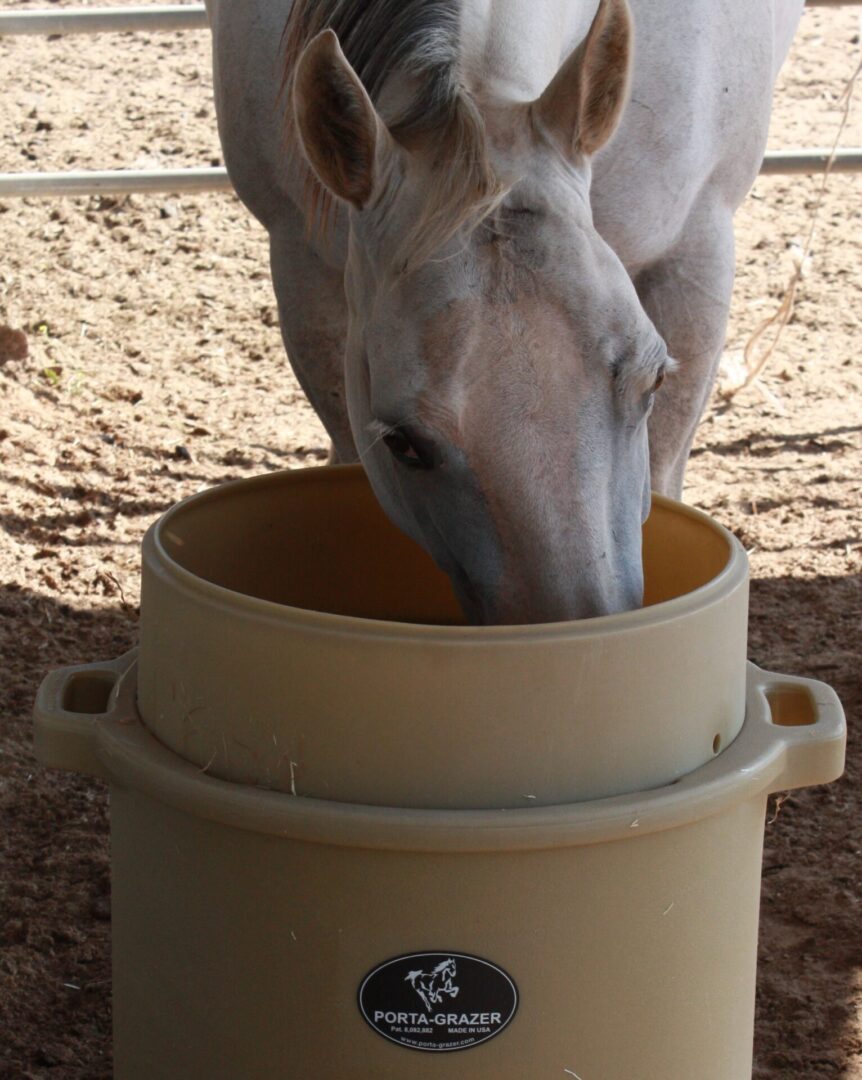A Hay Feeder that Fits Your Busy Schedule and Your Horse’s Digestive Needs

The health benefits of using a Porta-Grazer can help keep your equine partner healthy and content.
Porta-Grazer allows grazing when pasture is not an option.
Look at your horse
Take a minute to look at your horse’s world through his eyes. He has evolved from the beginning of his time to be on the move. Twenty-four hours a day, if necessary, to survive. He is agile and fleet of foot to evade the always present predators looking for him to be their next meal. He travels light. Due to having a small stomach (about 4 gallons). Constantly eating and moving. This is the mind and body of the pet in your paddock. Compare his natural feeding routine to the one you have provided him and you will see why he is not as healthy and content as he could be.
Hind gut fermentor
It is natural for a horse to travel and search for food constantly. Everywhere he looks there is food. He stands in it, walks in it, and lies on it. This is his world, he is a hind gut fermenting grazer. Meaning he searches, pulls, tears, chews and swallows in a continuous manner whenever he is hungry eating only enough to be satisfied and never to be full. Unlike humans that produce stomach acid when they eat, horses secrete a constant ongoing supply of stomach acid (16 gallons per day) to digest the constant supply of forage they require to survive. Horses do not have a gall bladder like humans to infuse large quantities of bile into their small intestine as they eat a meal. A horse’s liver supplies a constant supply of bile (10 liters per day) to the small intestines whether they are eating or not. And when there is no forage to buffer that stomach acid it can result in ulcers, bad habits - such as wood chewing, pawing, cribbing, and more.
Grazing and buffering the stomach acid
When grazing, horses search and tear each bite to a size that can be chewed thoroughly. Well chewed forage mixed with saliva is the beginning of the digestive process. Saliva production (10 gallons a day) is dependent on the movement of the jaw muscles. This alkaline mixture of saliva and forage buffers the stomach acid as it is being digested. He relies on the ph balance in the stomach to indicate when he has eaten enough. Remember horses do not eat to be full but only enough to not be hungry, thus the term trickle feeder.
How Porta-Grazer mimics natural grazing
The Porta-Grazer™ is designed to allow the horse to graze hay in a naturally slow continuous manner in the correct posture. Restrictive hay feeders and nets are designed to slow the horse down by force. Being restricted and forced causes heightened anxiety and can result in gastric ulcers. Also makes for an unhappy unhealthy lifestyle.
Horses are the only ones who know how fast or slow the should eat and each one has its individual needs. Porta-Grazers patented design offers hay to the horse in such a manner that each bite is pulled and torn to size resulting in a slowed rate of consumption. Searching-pulling-tearing while chewing and swallowing is natural and that’s Porta-Grazer™
–Walt Tharp
Videos explaining how and why Porta-Grazer works to keep your horse healthy.
Testimonials from Porta-Grazer users - Testimonials
Karen Chaton Endurance rider- shares here experiences using Porta-Grazer Karen Chaton
